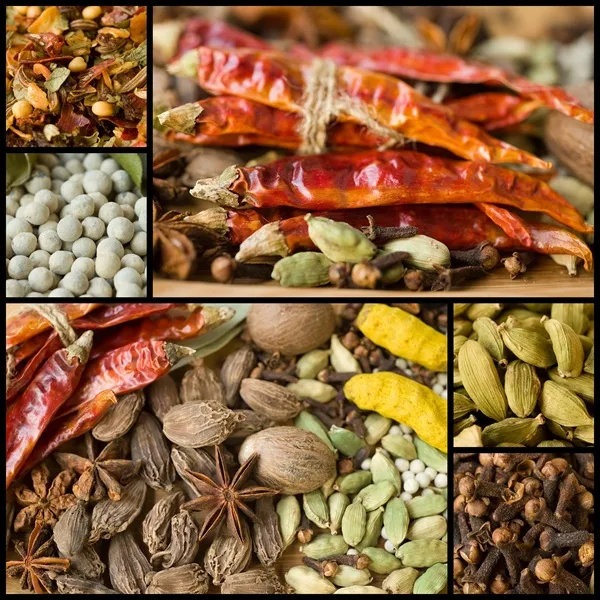Table of Contents
Indian Spices: A Symphony of Flavors and Heritage – A Comprehensive Guide
1. Introduction
Indian spices are the heart of a culinary tradition that spans millennia, offering vibrant flavors, health benefits, and cultural significance. From the fiery red chilies of Andhra Pradesh to the fragrant cardamom of Kerala, these spices define India’s diverse cuisine and global influence.
2. Key Indian Spices: Varieties & Tastes
- Turmeric (Haldi): Earthy, bitter; used in curries and Ayurvedic remedies.
- Cumin (Jeera): Nutty, warm; foundational in tadka (tempering) and spice blends.
- Coriander (Dhania): Citrusy seeds and fresh leaves; key in chutneys and garam masala.
- Cardamom (Elaichi): Aromatic, sweet (green) or smoky (black); stars in chai and desserts.
- Mustard Seeds (Rai): Pungent, nutty; used in pickles and South Indian curries.
- Fenugreek (Methi): Bitter seeds and leafy greens; essential in sambar and panch phoron.
- Asafoetida (Hing): Sulfuric, umami; a pinch enhances lentils and digestibility.
- Cloves (Laung): Sweet, pungent; used in biryanis and masala chai.
- Black Pepper (Kali Mirch): Sharp, hot; "King of Spices" from Kerala’s hills.
- Red Chili (Lal Mirch): Fiery; Andhra Pradesh’s Guntur chilies are iconic.
3. Culinary Uses
- Curries: Turmeric, cumin, and coriander form the base of masala pastes.
- Breads: Fenugreek leaves in methi paratha, kalonji (nigella) in naan.
- Desserts: Cardamom in kheer (rice pudding), saffron in rasgulla.
- Pickles & Chutneys: Mustard seeds and asafoetida in mango pickle.
4. Nutritional & Health Benefits
- Turmeric: Anti-inflammatory curcumin aids joint health.
- Cumin: Iron-rich, boosts digestion and immunity.
- Fenugreek: Regulates blood sugar; used in diabetes management.
- Cardamom: Antioxidant-rich, freshens breath.
- Ayurvedic Roots: Spices like ginger (adrak) and holy basil (tulsi) treat colds and stress.
5. Cultivation & Geography
- Kerala: Black pepper, cardamom (Western Ghats’ humid hills).
- Tamil Nadu: Turmeric (Erode, the "Turmeric City").
- Rajasthan: Cumin and coriander (arid climates).
- Andhra Pradesh: Red chilies (Guntur and Byadgi varieties).
- Climate Needs:
- Tropical: Cardamom (60–90% humidity, 10–35°C).
- Subtropical: Turmeric (well-drained soil, 20–30°C).
6. By-Products & Processing
- Essential Oils: Cardamom oil for perfumes, ginger oil for aromatherapy.
- Spice Blends: Garam masala, sambar powder, and chaat masala.
- Medicinal Products: Turmeric capsules, ashwagandha supplements.
7. Storage & Preservation
- Dried Spices: Store in airtight containers away from light (1–3 years).
- Fresh Herbs: Refrigerate coriander/mint in damp cloth (1 week).
- Freezing: Ginger and garlic paste can be frozen in ice cube trays.
8. Quick Recipes
- Masala Chai: Simmer black tea with cardamom, cloves, ginger, and milk.
- Aloo Jeera: Sauté potatoes with cumin seeds, turmeric, and green chilies.
- Mango Lassi: Blend yogurt, mango, cardamom, and a pinch of saffron.
9. Economic Impact: Trade & Production
- Top Producers: India leads globally in spice production (75+ varieties).
- Export Hubs: Kerala (pepper), Gujarat (cumin), Karnataka (sandalwood).
- Major Exporters: India ($4 billion annually), followed by Vietnam and China.
- Key Importers: USA, UAE, UK, and Saudi Arabia.
10. Home Planting Guide
- Easy-to-Grow:
- Coriander: Pots with well-drained soil; partial sun.
- Mint: Thrives in shade; prune regularly.
- Challenging:
- Cardamom: Requires humid, tropical conditions.
11. Pests & Organic Solutions
- Common Pests: Aphids (coriander), shoot borers (turmeric).
- Solutions: Neem oil spray, companion planting with marigolds.
12. Return on Investment (ROI)
- Costs:
- Turmeric Farming: ₹1.5–₹2 lakh/acre (labor, seeds).
- Black Pepper: ₹3–₹5 lakh/acre (trellises, shade nets).
- Profitability:
- Turmeric sells at ₹80–₹150/kg; organic spices fetch 30% premiums.
- Cardamom exports: ₹2,000–₹3,000/kg.
13. Sustainability & Innovations
- Organic Farming: Sikkim (India’s first organic state) leads pesticide-free cultivation.
- Solar Drying: Reduces waste and energy costs in spice processing.
14. Cultural Legacy
- Historical Trade: Kerala’s Malabar Coast was a spice route hub.
- Festivals: Onam and Pongal celebrate harvests with spice-laden feasts.
Conclusion
Indian spices are more than ingredients—they are storytellers of tradition, healers in Ayurveda, and economic pillars. From the misty Cardamom Hills to Rajasthan’s arid plains, they thrive in diverse landscapes, enriching global cuisines and wellness practices.
Pro Tip: Toast whole spices in a dry pan before grinding to intensify their aroma!
Savor the essence of India – where every spice tells a tale. 🌿🔥









